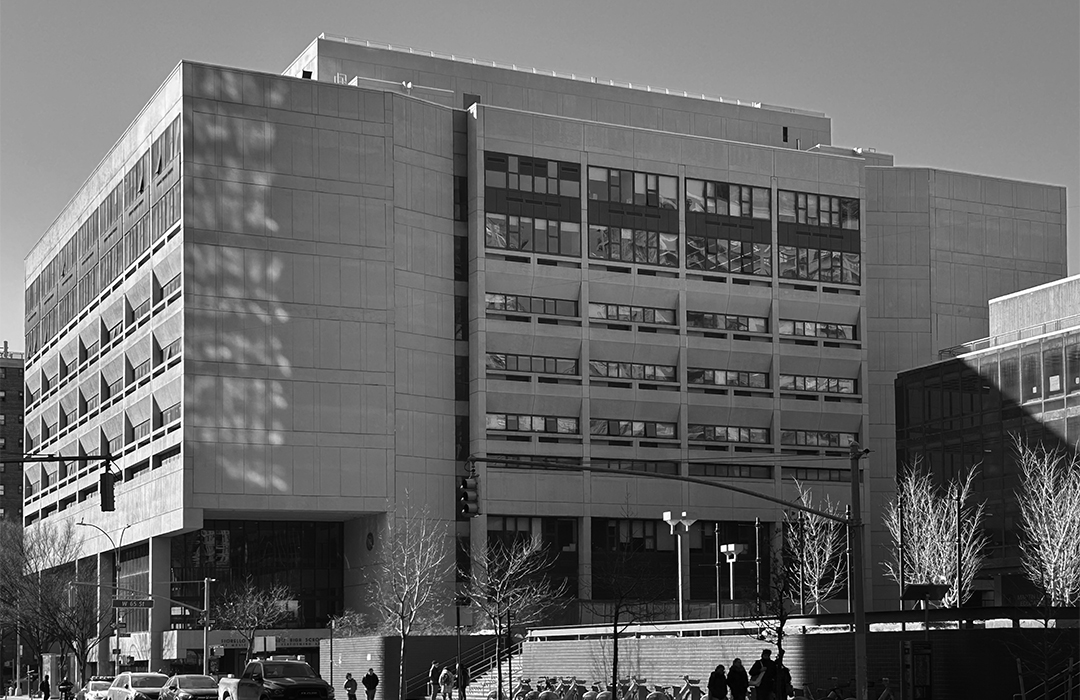
LaGuardia High School: 100 Amsterdam Ave.
by Tom Miller
The massive Lincoln Square Renewal Project that began in 1955 would eradicate the San Juan Hill neighborhood and displace more than 7,000 families. The centerpiece of the project would be the Lincoln Center for the Performing Arts. Among the structures was the Julliard School of Music at 60 Lincoln Center, completed in 1969. It was designed by Pietro Belluschi and Eduardo Catalano, whose travertine dressing continued the identity of the arts campus, which was tethered to via a pedestrian overpass.
As the Julliard School of Music considered relocating to Lincoln Center, a new public high school building was also proposed. The New York Times reported, “During the 1958 Easter vacation, officials of the High School of Music and Art were summoned to a meeting at school board headquarters and told of tentative plans for a handsome new building at Lincoln Center.”
In 1961, the High School of Music & Art and the High School of Performing Arts merged, becoming the Fiorello H. LaGuardia High School of Music & Art. At about the same the site for the new school–a motor vehicle repair shop at the corner of Amsterdam Avenue and 65th Street—appeared in the city budget. The year 1961, unfortunately, was also the year that the city began running out of money. And the city government’s fiscal crisis would only get worse.
Among those “deferments” was the construction of the LaGuardia High School of Music and the Arts.
Belluschi and Catalano were brought back in 1966 to design the LaGuardia High School of Music & Art. (This, despite the $12.2 million for the project’s not being allocated.) Arguably less dramatic than the Julliard School of Music building, the renderings depicted a structure of white concrete, voids that gave the illusion that portions were floating in air, and creative use of angles. The 2010 AIA Guide to New York City described it as, “A strongly articulated, poured-in-place concrete building typical of the best of 1960s construction.”
Four years after the architects submitted their plans, on December 1, 1970, The New York Times reported that the City Planning Commission had recommended “the abandonment and deferment of other projects.” Among those “deferments” was the construction of the LaGuardia High School of Music and the Arts. A year later, on December 11, 1971, The New York Times reported, “There is some hint from City Hall politicians that the proposed new school might be back in when the capital budget is adopted early next year.” At the time of the article, the school’s 1,900 students were making do in a 79-year-old building on West 46th Street. Finally, in 1984—18 years after Eduardo Catalano and Pietro Belluschi designed it, the LaGuardia High School building became reality.
Students were accepted only after auditioning in their chosen fields of dance, art, vocal music, instrumental music, drama, or technical theater. Those who made the cut might sometimes find themselves working with masters. That is what happened to instrumental music student Tandai Watkins on December 13, 1987, when jazz trumpeter Wynton Marsalis “jammed with students at the LaGuardia High School,” as reported by Newsday’s Biddle Duke. Watkins commented to Duke, “There are some things that are indescribable…like the artistic vibe in this room.”
And, in August 2024, 95 student musicians rehearsed for six days before playing in concert with the New York Philharmonic. They worked one-on-one with maestro Gustavo Dudamel, of whom 17-year-old Tritan Wiafe, a double bass player, said, “He’s like a god. He’s in the upper echelons of musical society. And now I just hope that we can impress him.”
The students were often recognized for their talents. On February 3, 1993, for instance, The Villager reported that dancer Miriam Francesca Parker, a senior, had won a grant given by the National Foundation for Advancement in the Arts.
95 student musicians rehearsed for six days before playing in concert with the New York Philharmonic.
One success story, however, was not only improbable, but it was inconceivable. In 2019, 13-year-old Paul Barreto moved from California, where he had been living with an abusive, drug addicted mother. In New York, he moved into a room in the New Yorker Hotel with his father. Paul took the bed and his father and boyfriend slept on the floor, according to The New York Times later. Unfortunately, said The Times, his father was “a delusional man with a short fuse.” After Paul missed a year of school, the Administration of Children’s Services started investigating. To avoid his father taking him back to California, Paul ran away. Later, in a foster home, he picked up a double bass. Paul Barreto, it turned out, was a prodigy.
The New York Times reported on December 23, 2024, after “taking just 11 lessons, he auditioned for and was accepted into the school’s music program.” Paul eventually earned a chair in the LaGuardia High School’s philharmonic orchestra and a spot at the Julliard School.
Among the celebrated alumni of the Fiorello H. LaGuardia High School of Music & Art are actors Gina Torres, and Timothee Chalamet.
Tom Miller is a social historian and blogger at daytoninmanhattan.blogspot.com


